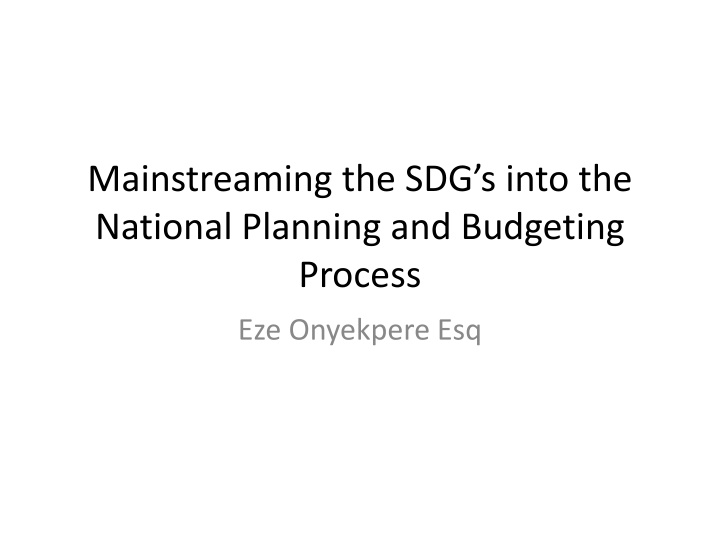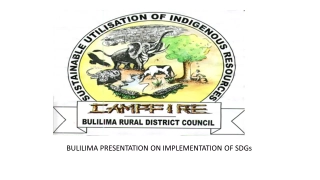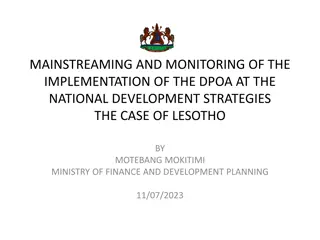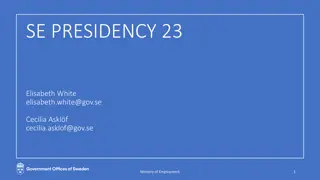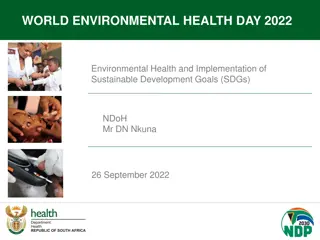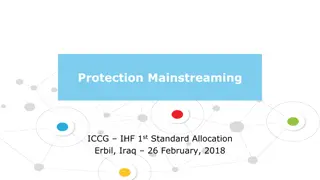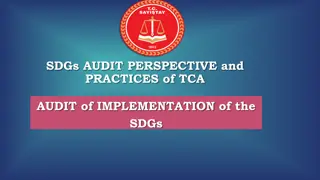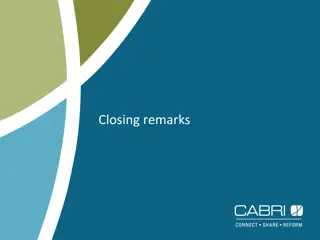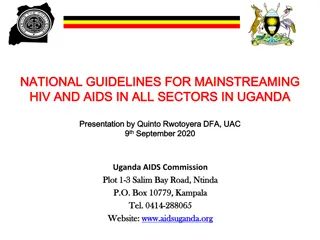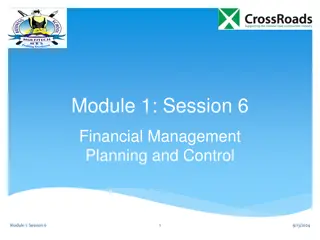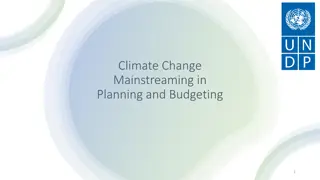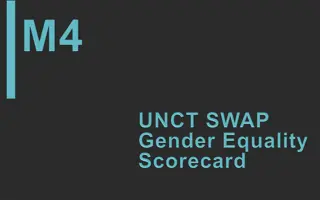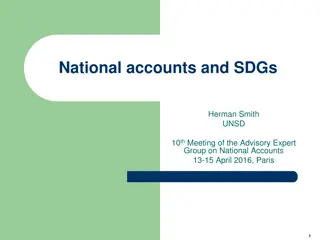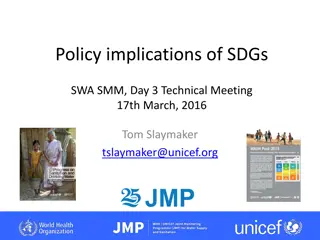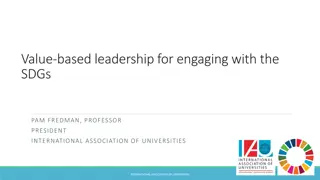Mainstreaming SDGs into National Planning and Budgeting
The presentation discusses re-engineering processes for achieving SDGs, focusing on budgeting, infrastructure, constituency projects, and policy continuity in Nigeria. It emphasizes evidence-led budgeting and setting federal priorities to avoid past mistakes.
Download Presentation

Please find below an Image/Link to download the presentation.
The content on the website is provided AS IS for your information and personal use only. It may not be sold, licensed, or shared on other websites without obtaining consent from the author.If you encounter any issues during the download, it is possible that the publisher has removed the file from their server.
You are allowed to download the files provided on this website for personal or commercial use, subject to the condition that they are used lawfully. All files are the property of their respective owners.
The content on the website is provided AS IS for your information and personal use only. It may not be sold, licensed, or shared on other websites without obtaining consent from the author.
E N D
Presentation Transcript
Mainstreaming the SDGs into the National Planning and Budgeting Process Eze Onyekpere Esq
Introduction I have a little misgiving about SDGs and its MDGs predecessor. They are quite nice concepts and worth background in human rights and fundamental freedoms tells me that that the language of goals and targets water down the language of rights. Just missing a target or goal is not exactly the same as being accused of violating a human right. pursuing. But my
Nigeria missed a lot of the MDGs and as such needs to re-engineer the processes and methodologies for the realisation of the SDGs so as not to repeat the mistakes of the past. And this is the domain of this 5 minutes brief presentation. What can we do better to get nearer the targets and goals? This discourse will address the subject matter in six key sub- headings.
Taking Budgeting Seriously We need to take budgeting beyond the formalities of MTEFs, MTSS and call circulars. In this context, we need to create an evidence led and rules based budgeting system that properly identifies duplications and learns experience. The federal budget needs to focus on matters on the Exclusive Legislative List and matters on the Concurrent List where states have not intervened. priorities, from avoid previous
A federal budget focus on building infrastructure for items that are reserved for states and LGA leads to a waste of resources because most times, they end up not being operated and maintained commissioning e.g., centres built without requisite agreements and consultations with the appropriate tier of government. after health their care primary
Constituency projects of legislators must be properly focused on federal priorities and on activities and programmes that deliver the highest value for money and best realises government s policies in the particular sector. Revenue forecasting should be evidence led so that variations during implementation will be no more than 5% rather than the overtly optimistic forecasts that leaves a lot of funding gaps in the budget.
Policy and Planning Framework Continuity Where are we in the implementation of NV 20:2020. After the 1stNational Implementation Plan (NIP) 2009-2013, there was no 2ndNIP and now we talk of a successor plan which ideally should have been the 3rdand final NIP of the Vision. We abandoned some of the policy targets and legislative agenda of the Vision and as such deprived ourselves of the full benefits of the provisions. A few examples below.
NV 20:2020 provided for a Project Continuity and Implementation Act which did not see the light of the day despite the efforts of the National Planning Commission and today, we are still lamenting about project abandonment after billions have been sunk. What happened to recommendation of using dollar certificates to infuse Federation Account oil revenue into the economy without creating new money at each point of infusion, tackle liquidity challenges, etc. the Monetary Policy
From the idea of creating a vibrant private sector led housing sector/market through mortgages and refinancing options, we are back in the 2016 budget to government s direct construction of housing. Why did we abandon the MTSS for so many years? Now we seek to resurrect the practice in 2016.
Coordinating Cross Cutting Issues To realise the SDGs, we need to properly coordinate cross mainstream them frameworks such as the budget. For instance, environmental challenges with serious impact in agriculture and water resources requires better coordination, especially when we consider the statistics on deforestation and desertification. cutting into issues implementation and
With a forest cover of about 7.7% of the entire Nigerian land area and a deforestation rate that is the highest in the world, having lost 50% of our 2000 forest cover by 2015; combined with a desertification rate that has taken about 62% of land area (15 Northern States are affected - 7 are severe and 8 are moderate); erosion and floods ravaging some parts of the South East, rising sea levels, the impact of all these on agricultural yields, rural and urban livelihoods and resource conflicts can better be imagined. It is time bomb.
One of the pillars of our environmental policy is the Polluter Pays Principle. Yet, there is no Remediation Fund established by law or policy. Natural resource extractors treat such issue as a matter of charity when indeed, they should be obliged by law to remediate the polluted environment. Thus, across the sectors of oil and gas and solid minerals, a certain percentage of the mining proceeds should be set aside by law to meet the environmental challenges posed by the extraction activity during and after the extraction.
Utilising all Available Resources There is too much focus on financial resources to the neglect of human, information, technological and ecological resources. Thus, we need to focus more on the use of these other resources through integrated management of available financial resources in such a way that it delivers across sectors. The Rwandan example of feeding meteorological information by cell phone and traditional media to agriculture productivity (continued) farmers to improve
and its extension services is not strictly about money but using available human resources to meet the information needs of farmers deploying already available technology. In this context, we also need to re-define poverty reduction beyond the sheer tokenism of providing tricycles, sewing and grinding machines, etc, to poor people in the rural and urban areas.
We need to use all available resources for development. For instance, it is unacceptable that funds in UBEC are un-accessed for basic education whilst majority of the states that have failed to access the funds are doing poorly in basic education. Some fundamental reforms are necessary to guarantee that all available resources development. are deployed for
Economic/Fiscal Governance Issues A monetary policy that is not coordinated with fiscal policy produces disastrous results for the economy. It makes no sense to leave the lending rate at around 25% whilst hoping to grow the economy to create jobs. In no reasonable country is this done. Harmonising fiscal and monetary policy is central to development. The expansionary fiscal contracting monetary policy cannot work or produce the desired results. current idea of policy matched with
Again, when the deposit rate is untied from the lending rate, it creates a huge disincentive to savings. Why should the deposit/saving rate be about 5% when the lending rate is over 20%. With inflation rate at 16.5%, are we not punishing depositors for keeping their money in the bank since the money loses value for being deposited in a bank? A corridor of between 500-700 basis points is needed between the deposit and lending rates. Otherwise, it is only a win for the banks and a loss for depositors.
Conclusion The budgeting process must be evidence led and focused on programmes, projects and activities that deliver to the greatest number and for the common good, with slight to pro- poor interventions. Policy and planning continuity is central to short, medium and long term development and realisation of SDGs.
Cross cutting coordination across the sectors will remove the current silo approach to planning and budgeting and place the larger picture at the centre of the process. Set up by law a Remediation Fund in the extractive industry implementation of the Polluter Pays Principle to facilitate the
Re-conceptualising deployment of resources will tap available but unused resources which had arisen from our debilitating fixation on financial resources. Coordinating fiscal and monetary policy is imperative for the realisation of SDGs our definition and
